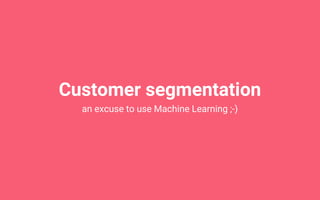Customer segmentation scbcn17
- 1. Customer segmentation an excuse to use Machine Learning ;-)
- 3. Ī± Julio Martinez Ī± Web developer since 2001 Ī± 2 years working at Ulabox Ī± Machine Learning hobbyist Ī± Find me: @liopic Who am I?
- 4. 1. docker pull jupyter/scipy-notebook 2. git clone git@github.com:ulabox/datasets 3. git clone git@github.com:liopic/scbcn17-customer-segmentation 4. cp datasets/data/*.csv scbcn17-customer-segmentation/ Preparing the workshop
- 5. My 2017 objective: M.L. Ī± Motivation Ī ItĪ»s the new hot thing Ī AlphaGo beat Lee Sedol, March 2016 Ī± Some background, but need to learn more
- 6. 1. Choose the way Ī CourseraĪ»s vs. books vs. workshops vs. posts 2. Find an excuse to apply it Ī @work is better than @home Learning about Machine Learning
- 7. Customer clusters @work, aka Ī░the excuseĪ▒ Ī± There is a non-programmer Business Analysis Department Ī± Groups of customers based on periodicity + amount spent Ī Example: people that buy once per month, 100Ć ticket Ī Useful for business reports Ī Not so useful for UX, CRM Ī± Groups by behavior? Clustering orders! Boring!
- 8. 1. With past data -> make a ML model Ī clean data Ī choose a ML algorithm/s Ī tune the algorithm, with testing 2. With new data -> use model to predict (or give new info) Ī deploy pipeline Ī update model 101 Machine Learning: the method
- 9. Ī± Supervised Ī data + labels(result) Ī± Unsupervised Ī just data Ī± Reinforcement Ī function to optimize 101 Machine Learning: type of problems
- 10. Supervised learning TRAINING SET cat cat person TEST SET ???
- 11. Unsupervised learning TRAINING SET TEST SET There is NO test
- 12. Ī± Try to extract features (information, shapes): similar and different Ī± Uses: Ī Clustering Ī Anomaly detection (it doesnĪ»t look Ī░normalĪ▒) Ī Dimensional reduction Ī Transfer features, projections ... Unsupervised learning
- 13. Ī± Use: Ī grouping Ī quantization Ī± Algorithms: Ī k-means Ī DBSCAN Clustering
- 14. Ī± need: how many clusters k-means
- 15. Ī± need: how many samples at minimum, tune other params DBSCAN: Density-based spatial clustering of applications with noise
- 16. So, ready to hack? But wait a moment!
- 17. Ī± Data preparation Ī Keep same order of magnitude, usually [0,1] Ī Remove noise Ī Other processes Ī÷ Binarize data, categorical features Ī± weekday, ex. 4 -> 0, 0, 0, 1, 0, 0, 0 Ī÷ Process missing data Before algorithms: data!
- 18. Ī± Explore the data Ī Images are richer than numbers Ī÷ Ī░We get more orders at 22hĪ▒ vs. Ī± Ask domain experts Ī Understand normal & border cases Ī÷ The step at 14h is the web cutoff time Before algorithms: data!
- 19. Ī± Explore and optimize the data Ī Features that count, feature engineering Ī Avoid the Ī░curse of dimensionalityĪ▒ Ī± Start small, understandable, useful Ī± Find excuses to try it, and sell it! Lessons learned
- 21. 1. docker pull jupyter/scipy-notebook 2. git clone git@github.com:ulabox/datasets 3. git clone git@github.com:liopic/scbcn17-customer-segmentation 4. cp datasets/data/*.csv scbcn17-customer-segmentation/ 5. cd scbcn17-customer-segmentation 6. ./jupyter.sh 7. Open the link in your browser and open the Workshop.ipynb file LetĪ»s hack
- 22. Thank you!

















![Ī± Data preparation
Ī Keep same order of magnitude, usually [0,1]
Ī Remove noise
Ī Other processes
Ī÷ Binarize data, categorical features
Ī± weekday, ex. 4 -> 0, 0, 0, 1, 0, 0, 0
Ī÷ Process missing data
Before algorithms: data!](https://image.slidesharecdn.com/customersegmentationscbcn17-171006211733/85/Customer-segmentation-scbcn17-17-320.jpg)




